Discussing island drought in Puerto Rico Part I
Bill Dennison ·We recently completed a series of eight ecological drought workshops in partnership with US Geological Survey (USGS) colleagues. These workshops were held in the following regions: Alaska, Hawaii, Northwest US, Southwest US, North Central US, South Central US, Northeast US, and Southeast US. In the Southeast workshop held in Raleigh, NC, Brent Murry who is based in Puerto Rico, highlighted the unique vulnerability of islands to drought. And when we held the Hawaii workshop, we recognized that the high islands of the Hawaiian archipelago were not representative of the diversity of the US Affiliated Pacific islands (e.g. Guam, American Samoa). Consequently, Shawn Carter from the National Climate Adaptation Science Center initiated two additional workshops to focus on island drought issues. Working with Jerry McMahon and Ryan Boyles and their excellent team from the Southeast Climate Adaptation Science Center, we held a workshop in San Juan, Puerto Rico on 30-31 May 2018 to focus on drought issues of the US Virgin Islands and Puerto Rico.
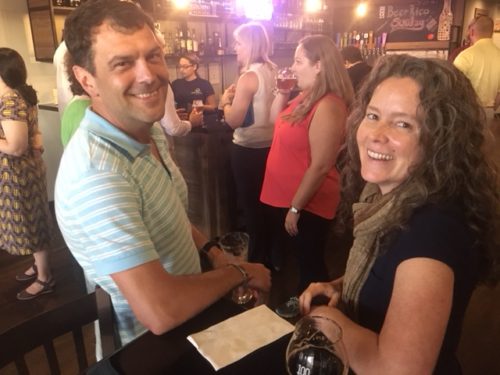
The workshop was hosted by Bill Gould from the US Department of Agriculture at the International Institute of Tropical Forestry in San Juan, in a beautiful botanical garden. I was accompanied by IAN staff members Jason Howard and Jamie Currie. Jamie worked closely with Aranzazu Lascurain and Melody Hunter-Pillion to collect oral histories from key representatives from the US Caribbean islands. They set up a makeshift film studio in the room adjoining our conference room and interviewed various people over a three-day period.
Bill Gould and his staff, Nora Alvarez-Berrios and Eva Holupchinski, did a great job recruiting speakers and participants to represent climate science, hydrology, ecology and agriculture with good geographic representation from the US Caribbean (Puerto Rico and US Virgin Islands). The workshop strategy was to have a few speakers give short, condensed plenary presentations to introduce the topic, followed by breakout group discussions with plenary report backs. Bill Gould provided the introduction in which he showed how the Caribbean islands are becoming warmer and drier, with increasing variability. Bill also highlighted the need for multiple communication mechanisms, including fact sheets, social media, videos and trainings.
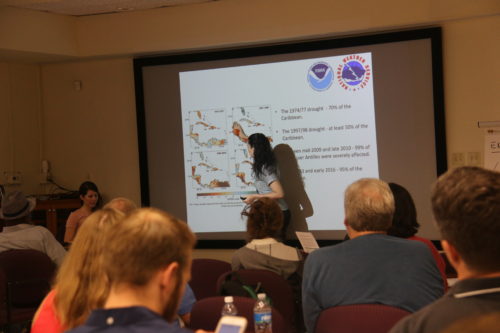
Agriculture: Odalys Martínez showed us the periodic frequency of drought (approximately every 20 years). Jose Castro, Edwin Más, Myrna Comas Pagán and Stuart Weiss introduced us to drought impacts on the diversity of island crops and livestock. The wide diversity of agricultural crops and practices on the islands means that drought responses are highly variable. The 2015 drought impacts on agriculture were over $13 million dollars. They told us that soil organic content was crucial in holding onto soil water and that cover crops and farming practices could help reduce overheated soil temperatures. We learned that 80% of the food consumed in Puerto Rico is imported, and the percent imported is even higher for the US Virgin Islands. The importance of agricultural best management practices (BMPs) was emphasized. For example, planting trees next to fields creates windbreaks, helping to reduce crop evapotranspiration and soil water loss.
Ecosystems: Jess Zimmerman and Tana Wood talked about the influence of Sahara dust on the 2015 drought that was particularly pronounced on Eastern Puerto Rico. Jess also showed us data from the Luquillo Long Term Ecological Research site in Puerto Rico and projected that the tropical forests will have a tipping point in 2036 for forest productivity due to projected increases in temperature and dryness. Pablo Gutiérrez talked about drought at the scale of the Caribbean and showed that native fish suffer and introduced fish thrive under drought conditions. Kristin Wilson Grimes talked about the ridge to reef concept of connecting land impacts of drought with adjacent coastal ecosystems like mangroves, seagrasses and corals. She also pointed out the data deficiencies throughout the US Virgin Islands.
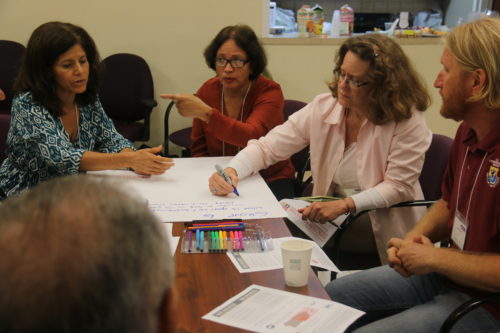
Water supply: Kristin talked about how the ghuts (ephemeral streams) were drying up due to groundwater wells and highlighted the importance of cistern water quality. She also introduced us to the recently formed US Virgin Islands Drought Work Group in response to recent droughts. Sigfredo Torres-Gonzalez showed us the different climatological regions of Puerto
Rico and the groundwater drought that occurred, accompanying the multi-year drought culminating in 2015. Pablo Mendez provided a human health perspective on drought and contrasted the rapid ecosystem response to Hurricane Maria with the ongoing slow infrastructure response.
Data needs and availability: Nora Alvarez-Berrios showed us great visualizations of drought features and highlighted that the social aspects of drought are as important as the physical aspects. Marianela Torres described the 2015 drought which led to 2653 wildfires, low reservoir levels, and reductions in water quality. Dorothy Sifuentes took us on a tour of the USGS drought websites. Stan Latesky talked about water quality in US Virgin Islands cisterns and introduced a recent University of the Virgin Islands graduate, Calwyn Morton. Calwyn outlined the data gathering exercise of using low cost sensors to track the microclimates of the US Virgin Islands.
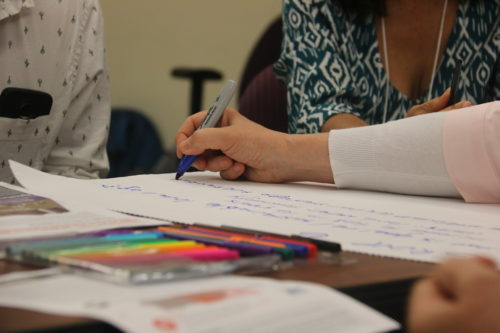
Adaptation strategies: Brad Rippey gave us a history of the US Drought Monitor, a popular and widely used website that is updated weekly on Thursday mornings. It was initiated in 1999 during a East coast drought which captured the attention of the Washington D.C. politicians. They use a truncated stoplight color scheme (yellow to orange and red). The Drought Monitor does not receive dedicated funding, yet it is widely used and it triggers disaster declarations and payments for agricultural losses. It reminds me of our Chesapeake Bay report card which also receives broad attention but does not have a dedicated funding stream. Kelly Smith introduced the concept of “Humans as sensors” in which media sources are used to document droughts in a “drought impact reporter.” The fact that media attributions typically identify cause-effect relationships, provide attribution and highlight impacts that matter to people enhance their utility.
During one of the initial breakouts, Christina Bandaragoda from the University of Washington drew elements of a conceptual diagram which depicted the infrastructure issues associated with drought. I sent her sketches to Brianne Walsh, who did not travel to Puerto Rico, but was able to quickly mock up a nice conceptual diagram.
Jared Bowden gave his talk on future drought scenarios in the form of a story, using Beauty and the Beast as a model. When he finished his talk, we co-performed the song “Rainfall and the Drought,” which I based on the Ashman and Menken song for the Disney movie.
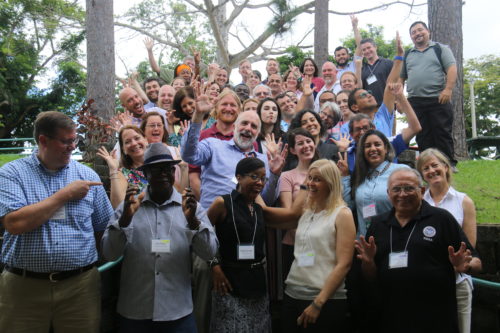
Rainfall and the Drought
Tale as old as time
True as it can be
Drought really sucks
Then something bends
Unexpectedly
Just a little change
Small to say the least
We’re a little scared
Neither island prepared
Rainfall and the drought
Ever just the same
Ever as a surprise
Ever as before and ever just as sure as the sun will shine
Ever just the same
Ever a surprise
Ever as before
Ever just as sure
As the sun will rise
Tale as old as time
Drought prediction can be wrong
Bitter sweet and strange
Finding that climate can change
Learning that we are often wrong
Tale as old as time
Song as old as rhyme
Rainfall and the drought.
About the author
Bill Dennison

Dr. Bill Dennison is a Professor of Marine Science and Interim President at the University of Maryland Center for Environmental Science (UMCES).
Next Post > Chesapeake Research and Modeling Symposium 2018
Comments
-
Atika 7 months ago
It's great to see the collaborative efforts between various organizations and experts to address ecological drought issues in different regions, especially focusing on the unique challenges faced by islands. Thanks for sharing!
-
Atika 4 months ago
Thank you for sharing this great information with us, i really appreciate your post!